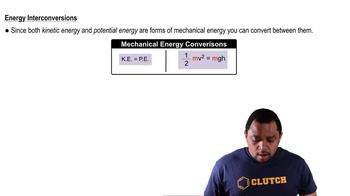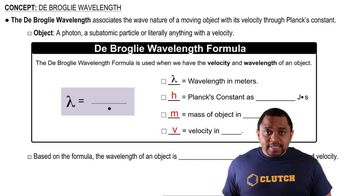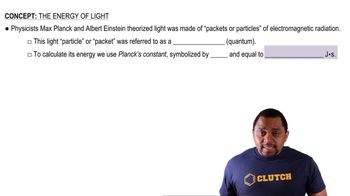The series of emission lines of the hydrogen atom for which nf = 3 is called the Paschen series. (a) Determine the region of the electromagnetic spectrum in which the lines of the Paschen series are observed.
An electron is accelerated through an electric potential to a kinetic energy of 1.6 * 10^-15 J. What is its characteristic wavelength? [Hint: Recall that the kinetic energy of a moving object is E = 1/2 mv^2, where m is the mass of the object and v is the speed of the object.]
 Verified step by step guidance
Verified step by step guidanceKey Concepts
Kinetic Energy

De Broglie Wavelength

Planck's Constant

The series of emission lines of the hydrogen atom for which nf = 3 is called the Paschen series. (b) Calculate the wavelengths of the first three lines in the Paschen series—those for which ni = 4, 5, and 6.
Determine whether each of the following sets of quantum numbers for the hydrogen atom is valid. If a set is not valid, then indicate which of the quantum numbers has a value that is not valid: e. n = 2, l = 2, ml = 1, ms = +1/2
As discussed in the A Closer Look box on 'Measurement and the Uncertainty Principle,' the essence of the uncertainty principle is that we can't make a measurement without disturbing the system that we are measuring. (a) Why can't we measure the position of a subatomic particle without disturbing it?
The Chemistry and Life box in Section 6.7 described the techniques called NMR and MRI. (c) When the 450-MHz photon is absorbed, does it change the spin of the electron or the proton on a hydrogen atom?
